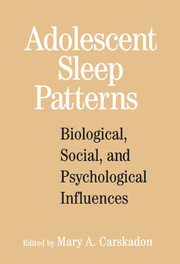Book contents
- Frontmatter
- Contents
- List of Contributors
- Foreword
- Preface
- Adolescent Sleep Patterns
- 1 Sleep and Adolescence: A Social Psychologist's Perspective
- 2 Factors Influencing Sleep Patterns of Adolescents
- 3 Endocrine Changes Associated with Puberty and Adolescence
- 4 Maturational Changes in Sleep-Wake Timing: Longitudinal Studies of the Circadian Activity Rhythm of a Diurnal Rodent
- 5 Nutrition and Circadian Activity Offset in Adolescent Rhesus Monkeys
- 6 Toward a Comparative Developmental Ecology of Human Sleep
- 7 Sleep Patterns of High School Students Living in São Paulo, Brazil
- 8 Sleep Patterns and Daytime Function in Adolescence: An Epidemiological Survey of an Italian High School Student Sample
- 9 Risks of Driving While Sleepy in Adolescents and Young Adults
- 10 What Can the Study of Work Scheduling Tell Us about Adolescent Sleep?
- 11 Accommodating the Sleep Patterns of Adolescents within Current Educational Structures: An Uncharted Path
- 12 Bridging the Gap between Research and Practice: What Will Adolescents' Sleep-Wake Patterns Look Like in the 21st Century?
- 13 Influence of Irregular Sleep Patterns on Waking Behavior
- 14 Stress and Sleep in Adolescence: A Clinical-Developmental Perspective
- 15 The Search for Vulnerability Signatures for Depression in High-Risk Adolescents: Mechanisms and Significance
- 16 The Regulation of Sleep-Arousal, Affect, and Attention in Adolescence: Some Questions and Speculations
- Index
- References
5 - Nutrition and Circadian Activity Offset in Adolescent Rhesus Monkeys
Published online by Cambridge University Press: 22 September 2009
- Frontmatter
- Contents
- List of Contributors
- Foreword
- Preface
- Adolescent Sleep Patterns
- 1 Sleep and Adolescence: A Social Psychologist's Perspective
- 2 Factors Influencing Sleep Patterns of Adolescents
- 3 Endocrine Changes Associated with Puberty and Adolescence
- 4 Maturational Changes in Sleep-Wake Timing: Longitudinal Studies of the Circadian Activity Rhythm of a Diurnal Rodent
- 5 Nutrition and Circadian Activity Offset in Adolescent Rhesus Monkeys
- 6 Toward a Comparative Developmental Ecology of Human Sleep
- 7 Sleep Patterns of High School Students Living in São Paulo, Brazil
- 8 Sleep Patterns and Daytime Function in Adolescence: An Epidemiological Survey of an Italian High School Student Sample
- 9 Risks of Driving While Sleepy in Adolescents and Young Adults
- 10 What Can the Study of Work Scheduling Tell Us about Adolescent Sleep?
- 11 Accommodating the Sleep Patterns of Adolescents within Current Educational Structures: An Uncharted Path
- 12 Bridging the Gap between Research and Practice: What Will Adolescents' Sleep-Wake Patterns Look Like in the 21st Century?
- 13 Influence of Irregular Sleep Patterns on Waking Behavior
- 14 Stress and Sleep in Adolescence: A Clinical-Developmental Perspective
- 15 The Search for Vulnerability Signatures for Depression in High-Risk Adolescents: Mechanisms and Significance
- 16 The Regulation of Sleep-Arousal, Affect, and Attention in Adolescence: Some Questions and Speculations
- Index
- References
Summary
Data have been presented by several investigators demonstrating a shift toward later bedtimes in teenagers. These data have practical implications for sleep deprivation, daytime sleepiness, school performance, and driving safety. However, it is not entirely clear from the human data to what extent later bedtimes are a consequence of changes in life-style (such as release from parental bedtime regulations, peer socialization activities, and part-time jobs) and to what extent they reflect a biologically driven maturation process. If biological maturation leads to the ability to stay up late or the ability to adhere to earlier bedtimes, then we can hypothesize that developmental trends in circadian activity are tied to other aspects of maturation during adolescence and will be disrupted by interventions that generally interfere with adolescent maturation. Data in this chapter suggest that adolescent trends in later sleep onset occur in nonhuman primates and can be disrupted by zinc deprivation, a nutritional intervention that leads to retardation of adolescent growth, skeletal, and sexual maturation. This is a new piece of information supporting the biological origin of altered bedtimes during adolescence. The background for the study is first presented, followed by data indicating that shift in the offset of daily activity normally occurs in rhesus monkeys during the period of adolescent maturation and that it can be prevented by zinc deprivation.
- Type
- Chapter
- Information
- Adolescent Sleep PatternsBiological, Social, and Psychological Influences, pp. 50 - 68Publisher: Cambridge University PressPrint publication year: 2002
References
- 6
- Cited by

